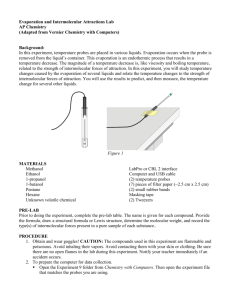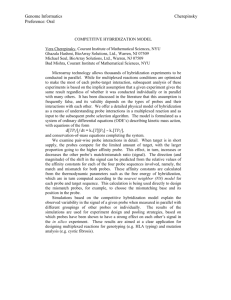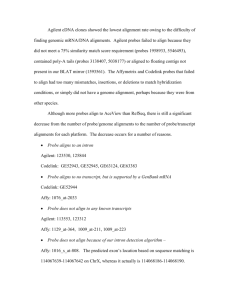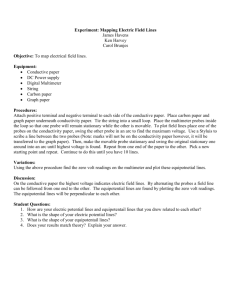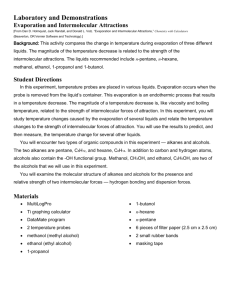VERNIER PROBES PURDUE UNIVERSITY INSTRUMENT VAN
advertisement
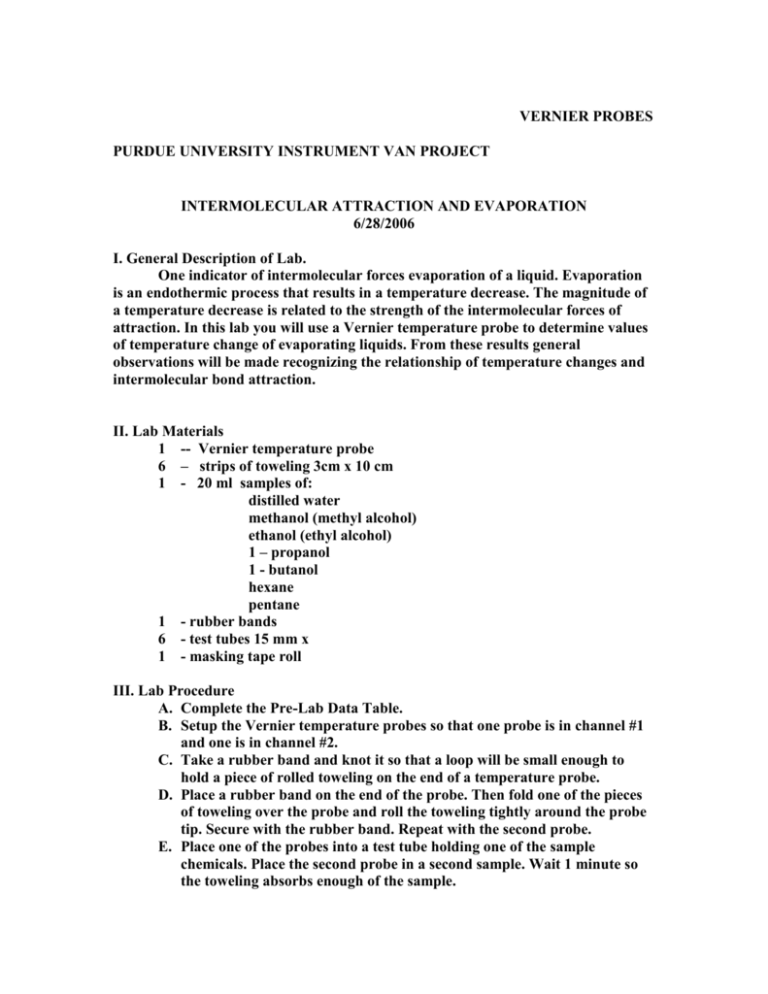
VERNIER PROBES PURDUE UNIVERSITY INSTRUMENT VAN PROJECT INTERMOLECULAR ATTRACTION AND EVAPORATION 6/28/2006 I. General Description of Lab. One indicator of intermolecular forces evaporation of a liquid. Evaporation is an endothermic process that results in a temperature decrease. The magnitude of a temperature decrease is related to the strength of the intermolecular forces of attraction. In this lab you will use a Vernier temperature probe to determine values of temperature change of evaporating liquids. From these results general observations will be made recognizing the relationship of temperature changes and intermolecular bond attraction. II. Lab Materials 1 -- Vernier temperature probe 6 – strips of toweling 3cm x 10 cm 1 - 20 ml samples of: distilled water methanol (methyl alcohol) ethanol (ethyl alcohol) 1 – propanol 1 - butanol hexane pentane 1 - rubber bands 6 - test tubes 15 mm x 1 - masking tape roll III. Lab Procedure A. Complete the Pre-Lab Data Table. B. Setup the Vernier temperature probes so that one probe is in channel #1 and one is in channel #2. C. Take a rubber band and knot it so that a loop will be small enough to hold a piece of rolled toweling on the end of a temperature probe. D. Place a rubber band on the end of the probe. Then fold one of the pieces of toweling over the probe and roll the toweling tightly around the probe tip. Secure with the rubber band. Repeat with the second probe. E. Place one of the probes into a test tube holding one of the sample chemicals. Place the second probe in a second sample. Wait 1 minute so the toweling absorbs enough of the sample. F. Precut four 10 cm lengths of masking tape. G. Set up the temperature probes to acquire samples every 10 seconds for 20 samples. H. Remove both probes from the liquids and tape each down so that they hang over the edge of a sink. Use the masking tape hold each probe still. Make sure the room is well ventilated, but not blowing air on the samples. A fume hood may be used, if possible. I. When the time interval is complete. Remove and discard the toweling from the probes. J. Repeat the same procedure for the rest of the samples, replacing new toweling to the probes with each new chemical. K. Construct separate graphs for each of the seven chemicals. L. Use each graph to determine the change in temperature for each chemical. M. Complete the given data table. Pre-Lab Data Table Structural Formula Substance Methanol Ethanol 1-Propanol 1-Butanol Hexane Pentane Water Formula Molecular Weight Intermolecular Forces (H-bond or dispersion) Data Table Substance T2 (Co) T1 (Co) Temperature Change Methanol Ethanol 1-Propanol 1-Butanol Hexane Pentane Water IV. Questions and Discussion A. List the chemicals that have predominantly H-bonds, besides water. B. List the chemicals that have predominantly dispersion forces of attraction? C. Which forces of attraction appear to be “stronger”, dispersion forces or H-bond attraction? D. Which of the alcohols has the strongest intermolecular forces of attraction? Which has the higher molecular mass? E. Which of the alkanes has the strongest intermolecular forces of attraction? Which has the higher molecular mass? F. Plot a graph of the mole mass of the alcohols on the x-axis and the temperature change on the y-axis. Describe what pattern you recognize. G. Describe what you see regarding the results of water. Propose an explanation for this behavior.

